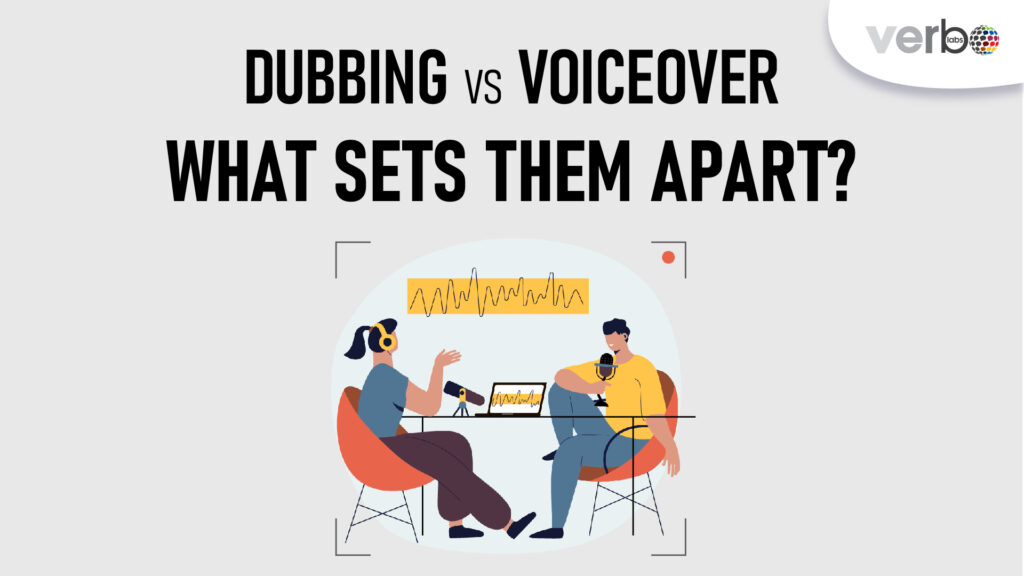Dubbing and voiceover are both integral components of audio production. But in the battle of dubbing vs voiceover, which is better? Each serves distinct purposes in various media forms. While often used interchangeably, they possess fundamental differences that distinguish them. Understanding this is crucial to understanding what voiceover vs dubbing is about, which one is better, and how you can make the right choice for your brand.
Dubbing involves replacing the original dialogue in a film or video with a translated version. It ensures seamless integration with the visuals. Conversely, voiceover entails the addition of a narrator’s voice to provide commentary, narration, or supplementary information, typically over existing footage. Understanding the disparities between dubbing and voiceover is crucial for professionals in any industry, as each technique offers unique benefits.
Let’s understand the critical distinctions and help you choose the best solution to this dubbing vs voiceover dilemma.
Understanding dubbing
Dubbing is a post-production technique used in filmmaking and audiovisual media to replace the original dialogue or soundtrack with a new version in a different language. This process involves recording the conversation in the desired language and synchronizing it with the lip movements of the actors on screen. Dubbing enables films, television shows, and other content to reach audiences who speak different languages.
The primary purpose of dubbing is to make content available to viewers who do not understand the original language in the film or video. It involves translating the dialogue accurately while preserving the context, tone, and emotions conveyed in the original performances. Skilled dubbing artists or voice actors are responsible for delivering the lines in a manner that matches the lip movements of the narrator on screen.
Its significance in making audiovisual content accessible to global audiences and appreciating the skill required to produce high-quality dubbed versions is paramount.
Exploring voiceover
Voiceover involves the addition of a narrative voice to accompany visuals, providing context, explanation, or character dialogue. Unlike dubbing, which replaces original dialogue, voiceover supplements existing audio content without altering the original soundtrack. This technique is widely used in documentaries, commercials, instructional videos, and animated films to convey information, guide the audience, or evoke emotions.
Voiceover artists play a crucial role in delivering the narrative effectively, employing various vocal techniques to capture the tone, mood, and style required for the production. From providing insightful commentary to breathing life into animated characters, voiceover adds depth and clarity to visual storytelling.
In the case of voiceover vs dubbing, voiceover complements visuals by providing additional information or commentary. In documentaries, a narrator’s voice guides viewers through the subject matter, offering insights, explanations, and historical context.
Unlike dubbing, which requires lip-syncing and synchronization with on-screen movements, voiceover allows for greater flexibility in timing and delivery. Whether used for educational, promotional, or artistic purposes, it serves as a versatile tool for enhancing the storytelling experience across various forms of media.
Key differences: dubbing vs voiceover
Dubbing and voiceover are two distinct techniques used in audiovisual media, each serving specific purposes and involving different approaches. Understanding the differences between them is crucial for effective communication and production quality. Let’s see which technique serves what purpose in the case of voiceover vs dubbing.
Purpose:
- Dubbing: Dubbing services primarily aim to replace original dialogue in a foreign language with translated dialogue in the target language while maintaining lip-sync with the on-screen characters.
- Voiceover: Voiceover, on the other hand, involves adding a narrative voice to complement existing audiovisual content, providing explanations, commentary, or character dialogue without altering the original soundtrack.
Execution:
- Dubbing: Dubbing requires meticulous synchronization between the replacement dialogue and the lip movements of the actors on screen to ensure seamless integration and natural lip sync.
- Voiceover: Voiceover does not require lip-syncing. The narrator’s voice can be added independently of the on-screen visuals, enabling smoother integration with the existing audio and video elements.
Application:
- Dubbing: Dubbing is commonly used in film and television productions to make content accessible to audiences who speak different languages. It is also prevalent in animation, where characters’ voices are replaced to match the target audience’s language.
- Voiceover: Voiceover finds application in various media formats, including documentaries, commercials, instructional videos, and animated films. It provides additional information, explanations, or narrative context to enhance the viewer’s understanding and engagement.
Flexibility:
- Dubbing: Dubbing involves precise timing and adherence to lip movements. It must closely match the original dialogue’s timing and rhythm to maintain coherence and authenticity.
- Voiceover: Voiceover offers greater flexibility in delivery and timing since it does not require synchronization with on-screen movements. Narrators can adjust their pacing and intonation to suit the content’s tone and mood.
Advantages and disadvantages
To pick the best option in this battle of dubbing vs voiceover, here are the advantages and disadvantages of these services.
Advantages of dubbing:
- Multilingual accessibility: Expands the audience reach by providing content in multiple languages, increasing international viewership.
- Cultural adaptation: Tailors dialogue to suit local cultures and idioms, enhancing audience connection and understanding.
- Enhanced visuals: Ensures lip-sync accuracy, maintaining the illusion of natural dialogue and improving overall visual appeal.
- Professional voice talent: Utilizes skilled voice actors for authentic performances, enriching character portrayals.
- Global appeal: Breaks language barriers, making content more relatable and marketable globally.
Disadvantages of dubbing:
- Loss of original performance: Risks diluting the authenticity and emotional impact of the original actors’ performances.
- Translation challenges: Requires precise translation to maintain context and meaning, posing linguistic and cultural hurdles.
- Technical constraints: Demands meticulous audio editing and synchronization, increasing production complexity and costs.
- Audience reception: Poor execution may lead to dissonance between audio and visuals.
Advantages of voiceover:
- Clarity and consistency: Provides clear narration for informational content, ensuring audience understanding and engagement.
- Cost-efficiency: Offers a cost-effective solution for adding narration to videos, compared to full dubbing processes.
- Flexibility: Allows for quick revisions and updates to audio content without the need for extensive re-recording.
- Versatility: Can be used across various media formats, including documentaries, presentations, and instructional videos.
Disadvantages of voiceover:
- Limited emotional depth: May lack the emotional depth and impact of on-screen performances, particularly in dramatic scenes.
- Language barrier: Limits accessibility for non-native speakers unless translations or subtitles are provided.
- Narrative flow: Requires skilled narration to maintain engagement, as monotone delivery can lead to listener disinterest.
- Lip-sync challenges: In animation or lip-synced videos, voiceover may not match character movements, affecting visual coherence.
Considerations in choosing between dubbing and voiceover
To pick the best option in the middle of dubbing vs voiceover, here are all the factors you should consider:
- Cultural context: Assess the cultural nuances of the target audience. Dubbing is often preferred for films and TV shows to maintain authenticity and emotional resonance, while voiceover may be more appropriate for instructional or documentary content.
- Linguistic accessibility: Determine the language proficiency of the target audience. Dubbing expands accessibility for non-native speakers by providing synchronized dialogue in their native language, whereas voiceover requires reliance on subtitles or translations.
- Budget and resources: Evaluate available resources and budget constraints. Dubbing typically involves higher production costs due to the need for skilled voice actors and audio synchronization, while voiceover may offer a more cost-effective solution for narration or commentary.
- Time constraints: Consider project timelines and deadlines. Voiceover can be completed relatively quickly, making it ideal for time-sensitive projects or content updates. In contrast, dubbing requires meticulous audio synchronization and may prolong production schedules.
- Genre and content type: Analyze the genre and nature of the content. Dubbing is well-suited for narrative-driven films, TV shows, and animations, whereas voiceover may be preferable for informational videos, presentations, or documentaries where clarity and consistency are paramount.
- Audience engagement: Reflect on the desired level of audience engagement. Dubbing preserves the original performances and emotional impact of actors, enhancing viewer immersion and connection. On the other hand, voiceover provides a clear and concise narration focused on conveying information.
Conclusion
While dubbing and voiceover are essential techniques in audiovisual production, they offer distinct approaches to conveying dialogue and narrative. Dubbing emphasizes synchronization and cultural adaptation. In contrast, voiceover prioritizes clarity, making it suitable for informational content and multilingual communication. Ultimately, the dubbing vs. voiceover battle winner depends on the audiovisual project’s specific goals, context, and constraints of your business. If you need the best organization to address either of these needs, contact VerboLabs now! Don’t forget to pick your preference in the comments section.
FAQs
- Can voiceover or dubbing alter the original intent or context of the content?
Yes, both can change the original context due to translation differences and voice performance variations.
- What are the qualifications and skills required for voice actors and dubbing artists?
Both need acting skills, language proficiency, and the ability to convey emotion through voice.
- What are some emerging trends or innovations in voiceover and dubbing technology?
AI-driven tools, cloud-based platforms, and interactive voice technologies are transforming the industry to a great extent.



